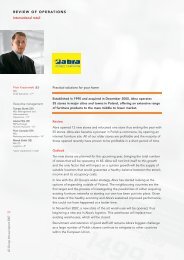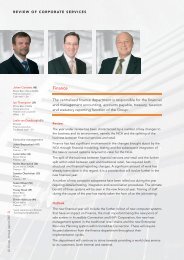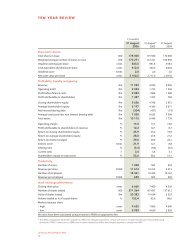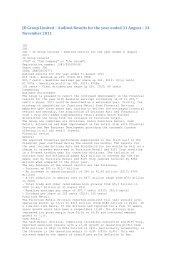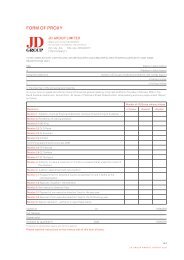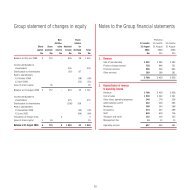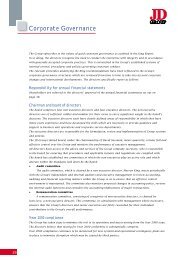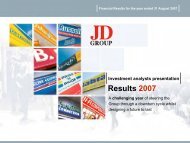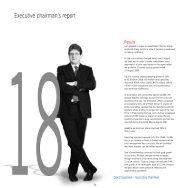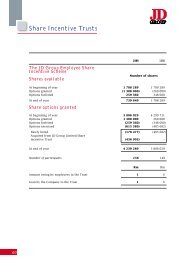Annual Report - JD Group
Annual Report - JD Group
Annual Report - JD Group
You also want an ePaper? Increase the reach of your titles
YUMPU automatically turns print PDFs into web optimized ePapers that Google loves.
Basis of accounting<br />
The annual financial statements are prepared on the historical cost<br />
basis, except for certain financial instruments carried at fair value,<br />
and are in accordance with South African Statements of Generally<br />
Accepted Accounting Practice and International Financial <strong>Report</strong>ing<br />
Standards, and incorporate the following principal accounting<br />
policies, which are consistent in all material respects with those of the<br />
previous year, except for that relating to the consolidation of share<br />
incentive trusts which is explained in detail later in these policies.<br />
The annual financial statements are presented in South African<br />
rand since this is the currency in which the majority of the <strong>Group</strong>’s<br />
transactions are denominated.<br />
Consistent with prior financial reporting periods the trading cycle<br />
ends on the 15th of each following month. The financial year ends<br />
on 15 September.<br />
Basis of consolidation<br />
The <strong>Group</strong> financial statements incorporate the financial<br />
statements of the Company and its subsidiaries. Subsidiaries are<br />
those entities over whose financial and operating policies the<br />
<strong>Group</strong> has the power to exercise control, so as to obtain benefits<br />
from their activities.<br />
On acquisition, the assets and liabilities of the subsidiaries are<br />
measured at fair value. The results of subsidiaries are included<br />
from the effective dates of acquisition and up to the effective<br />
dates of disposal. All intercompany transactions and balances are<br />
eliminated on consolidation.<br />
The accounting policies and year ends of all consolidated<br />
subsidiaries are consistent throughout the <strong>Group</strong>. The<br />
consolidation of Abra SA for the year ended 31 August 2004 is<br />
based on audited results and for BoConcept unaudited<br />
management account information was used.<br />
The assets and liabilities of foreign subsidiaries are translated into<br />
rand at rates of exchange ruling at the year end. The results of<br />
their operations are translated at an appropriate weighted average<br />
rate of exchange for the year.<br />
Subsidiaries acquired with the intention of disposal in the<br />
foreseable future are not consolidated.<br />
Goodwill<br />
Goodwill arising on consolidation represents the excess of the cost<br />
of acquisition over the <strong>Group</strong>’s interest in the fair value of the<br />
25<br />
Accounting policies<br />
identifiable assets and liabilities of a subsidiary, associate or jointly<br />
controlled entity at the date of acquisition. Goodwill is capitalised<br />
and amortised on a straight line basis over its estimated useful life,<br />
not exceeding 20 years, and is assessed for impairment. Goodwill<br />
arising on acquisitions by foreign entities is treated as assets and<br />
liabilities of the foreign entity and translated into rand at rates of<br />
exchange ruling at the reporting date.<br />
Intangibles<br />
Intangibles are stated at cost if acquired separately or at fair value<br />
at the date of acquisition in a business combination. The fair value<br />
is limited to the extent of positive goodwill existing after the<br />
allocation of the purchase consideration to the net tangible assets.<br />
Intangibles are amortised on a straight line basis over their<br />
estimated useful lives.<br />
Taxation<br />
The charge for taxation is based on the results for the year as<br />
adjusted for items which are non-assessable or disallowed.<br />
Deferred taxation is accounted for using the balance sheet liability<br />
method in respect of temporary differences. Temporary differences<br />
arise from differences between the carrying amount of assets<br />
and liabilities in the financial statements and the corresponding<br />
taxation basis used in the computation of assessable taxable profit.<br />
In general, deferred taxation liabilities are recognised for all taxable<br />
temporary differences and deferred taxation assets are recognised<br />
to the extent that it is probable that taxable profit will be available<br />
against which deductible temporary differences can be utilised.<br />
Such assets and liabilities are not recognised if the temporary<br />
difference arises from goodwill or from the initial recognition of<br />
other assets and liabilities which affects neither the taxable profit<br />
nor the accounting profit at the time of the transaction.<br />
Deferred taxation liabilities are recognised for taxable temporary<br />
differences associated with investments in subsidiaries and<br />
associates, and interests in joint ventures, except where the <strong>Group</strong><br />
is able to control the reversal of the temporary difference and it is<br />
probable that the temporary difference will not reverse in the<br />
foreseeable future.<br />
Deferred taxation is calculated at the taxation rates that are<br />
expected to apply to the period when the asset is realised or the<br />
liability is settled. Deferred taxation is charged or credited in the<br />
income statement, except when it relates to items credited or<br />
charged directly to equity, in which case the deferred taxation is<br />
also dealt with in equity.





